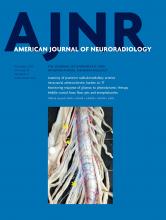Atherosclerosis involves gradual arterial hardening secondary to the building up of lipid-laden plaques in the vessel wall, which may cause vascular stenosis, thromboembolism, or overgrowth across perforator arterial ostia.1,2 Despite common vascular risk factors and overlapping atherogenic molecular pathways, differential prevalence, onset, and progression of atherosclerosis exist across arterial beds and ethnic groups (eg, inordinate prevalence of intracranial atherosclerosis in Asians and Africans in epidemiologic data), suggesting multifactorial variation underlying the expression of this systemic disease.2⇓⇓⇓⇓⇓–8 Intracranial large-artery atherosclerosis is a known strong risk factor for ischemic stroke, associated with a high risk of recurrent ischemic stroke.1 However, it is generally perceived to be etiologically different from extracranial disease.3⇓–5,8
Recent technologic advances improving the clinical applicability of 3D high-resolution intracranial vessel wall imaging challenge these traditional assumptions.5⇓–7,9 Because vascular remodeling in the form of compensatory dilation may occur secondary to plaque formation, traditional lumen-based approaches such as CT or MR angiography on which some historical epidemiologic or symptomatic stroke studies were based could underestimate the true prevalence of underlying intracranial atherosclerosis.4,6⇓⇓⇓–10 In contrast, vessel wall imaging allows simultaneous study of both stenotic and nonstenotic atherosclerotic vessel wall lesions, better reflecting the true prevalence of intracranial atherosclerotic burden.7,9 Hence, vessel wall imaging offers the opportunity to elucidate the pathophysiologic underpinnings of intracranial large-artery atherosclerosis, which may serve as potential targets for stroke prevention and treatment.5,7 Recent interest has been directed to the reliability of vessel wall imaging in epidemiologic characterization of intracranial atherosclerotic burden in population-based studies.7,9
The article by Zwartbol et al11 in this issue of the American Journal of Neuroradiology offers incipient evidence of an association of extracranial atherosclerosis and intracranial atherosclerotic burden based on a simple uniparametric score of vessel wall lesion count. Using 7T vessel wall MR imaging, the authors reported on the intracranial atherosclerotic burden on a cross-sectional analysis of 130 patients with second manifestations of arterial disease in various vessel beds, recruited under the SMART-MR study. Besides a clear majority (96%) of patients having at least 1 intracranial arterial vessel wall lesion, there is a significant association of intracranial atherosclerotic burden with atherosclerotic disease in all examined extracranial arteries (ie, carotid intima-media thickening, 50%–100% carotid stenosis, an ankle-brachial index of ≤0.9, and renal dysfunction), leading the authors to conclude that contrary to popular belief, intracranial and extracranial atherosclerosis were more similar than different in atherogenic mechanisms and etiology.
Literature on the relationship between systemic and intracranial atherosclerotic disease is scant and wanting. A recent French study of 403 patients with stroke by Hoshino et al12 found significant ($50%) intracranial atherosclerotic stenosis in only a 36.2% minority by lumenographic imaging, with concomitant aortic arch and coronary artery atherosclerosis more often coexisting. While the male-dominant cohort studied by Zwartbol et al11 is small in epidemiologic terms, it is valuable and useful as one of the largest studied with 7T vessel wall MR imaging to date.7,9 The analysis of extracranial atherosclerosis was comprehensive, and the team should be commended for their clear and succinct charting of the markers of extracranial atherosclerosis and assessment of vascular risk factors. The authors are well-established and competent in vessel wall imaging assessment.13 Improved accuracy with ultra-high-field in vivo vessel wall MR imaging14 and a detailed description of vessel wall lesion rating criteria lend credibility to their findings of high intracranial plaque burden, which were consistent with postmortem reporting of plaque frequency and distribution.15
We eagerly await validation of these findings in larger prospective population studies incorporating intracranial vessel wall MR imaging with systemic atherosclerosis assessment, and especially in vulnerable cohorts such as Asians and Africans.1,3 Future evaluation of luminal stenosis and vessel wall MR imaging in tandem, in addition to brain ischemic events, would allow even more comprehensive appraisal and characterization of intracranial atherosclerotic burden with respect to severity, vascular remodeling, and hemodynamic impact. Technologic and protocol refinements further reducing scan time, while maintaining spatial and contrast resolution,13 could also make vessel wall MR imaging more clinically accessible to the patient in this age of precision medicine and could deepen our insights into stroke pathophysiology.
References
- © 2019 by American Journal of Neuroradiology












